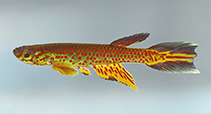| Diagnosis: |
Dorsal spines (total): 0-0; Dorsal soft rays (total): 7-9; Anal spines: 0-0; Anal soft rays: 13-14; Vertebrae: 28-28. Diagnosis: With the exception of Aphyosemion congicum, males of A. fellmanni can be distinguished from all other Aphyosemion species by the wide black margins of the dorsal and caudal fin, up to50% of dorsal fin versus 23% in other species, up to 22% of fin height in caudal fin versus 14% in other species; these margins sometimes seem to be blueish white to grey depending on light incidence, as is also the case in A. congicum (Ref. 119321). Males differ from A. congicum by having many red spots on the flanks versus few red spots, more than 70 versus 30 or less; striped red markings in the caudal fin, versus red spots; red spots on the base of the pectoral fin, versus unspotted pectoral fins; presence of a buccal red band and red pigmented throat, versus unmarked throat; ventral black edge in caudal fin as wide as dorsal edge, versus ventral black edge much wider than dorsal edge; and many stripes or large red spots in anal fin, versus only single or a small number of tiny red spots (Ref. 119321). Although it has narrower dark fin edges, Aphyosemion rectogoense resembles A. fellmanni in colour pattern of sides and anal fin, but the interradial red streaks of the anal fin often forms a broad red band at the anal fin base in A. rectogoense; furthermore the pectoral fins of A. fellmanni are mainly yellow with some red spots at the proximal part of the fin, sometimes forming a horizontal red stripe at about fin centre, whereas pectoral fins of A. rectogoense are mainly red with a yellow or whitish edge (Ref. 119321). The sympatric occurring A. schioetzi sometimes has dark red, not black, fin edges, but these are narrow, less than 23% of dorsal fin height and less than 12% of caudal fin height, and it has no red streaks in the unpaired fins and unspotted pectoral fins (Ref. 119321). Aphyosemion labarrei and A. teugelsi are the only other species of Aphyosemion s.l. of which at least some populations have broad black edges in the caudal fin; these species however can easily be distinguished from A. fellmanni by their robust general appearance and the higher number of dorsal fin rays, 7-9 versus 12-14 in A. labarrei and 10-13 in A. teugelsi (Ref. 119321).
Description: Aphyosemion fellmanni is a moderate sized, slender, elongate species (Ref. 119321). Laterally slightly compressed, dorsal profile slightly convex, greatest body depth approximately anterior or at pelvic fin insertion; ventral profile slightly convex from head to end of anal fin, straight or slightly concave on caudal peduncle; caudal peduncle slender, peduncle depth is 1.7-2.1 times in length (Ref. 119321). Snout slightly rounded, mouth directed upwards, lower jaw longer than upper jaw (Ref. 119321). Dentary with outer row of large and inner irregular rows of smaller unicuspid, curved teeth; premaxilla with some larger and several smaller unicuspid and curved teeth (Ref. 119321). Cephalic lateral line system: frontal neuromasts in separate grooves, preopercular canal with six pores, preorbital canal with two pores, postorbital canal with two pores, supraorbital system compact with three very small outer lobes, or outer lobes absent, and two well developed inner lobes; the anteriormost neuromast of the supraorbital system is slightly longer than the other two neuromasts of this system and positioned at the same level as the frontal neuromasts (Ref. 119321). Scales cycloid, entirely scaled except ventral surface of head; frontal squamation of G-type; scales on mid-longitudinal series 27-30, with two or three scales posterior to hypural plate; 15-17 transversal scales, 11-12 scales around caudal peduncle (Ref. 119321). Narrow dorsal fin with 7-9 fin rays, first dorsal fin ray inserts above 7-9th anal fin ray; anal fin with 13-14 rays; posterior dorsal and anal fin rays slightly elongated in males; caudal fin with 22-25 rays; with short extensions on upper and lower fin rays in males (Ref. 119321). Twelve pre-caudal and 16 caudal vertebrae, total 28 (Ref. 119321).
Colouration: Live colouration: males with flanks with yellowish to green iridescence on light blue background, dorsally grading into brown, ventrally into white; most upper and posterior flank scales with red dots; dots often connected forming short oblique streaks, v- or x-patterns; anterior ventral scales with few red dots; three red streaks on opercle in an approximate 45° angle; ventral part of opercle with several red dots; red dots underneath the eye sometimes united in a red streak; one infrabuccal red band on lower jaw; throat with red dots arranged in two or three interrupted lines; dorsal fin with broad distal black margin, followed by a dark red band and a narrow yellow base with lighter red spots or streaks; anal fin yellow with a, sometimes incomplete, narrow black margin, provided with interradial red streaks that reach from the fin base to just into distal half of the fin; caudal fin yellow with very broad black dorsal and ventral edges and dark red dorsal and ventral submarginal stripes; depending on the light incidence, black margins with strong blueish white to grey iridescence; centre of the fin provided with long red interradial streaks; pectoral and pelvic fins yellow with some red spots or stripes (Ref. 119321). females with flanks grey, dorsally grading into brown, ventrally light grey to whitish; flanks with dark grey reticulation and many small red spots, anteriorly arranged in rows; red streaks on opercle reduced and infrabuccal band absent; all fins transparent; distal margin of anal fin dark grey; small spots on anal fin, more prominent spots on base of dorsal and dorsal part of caudal fin (Ref. 119321). |

